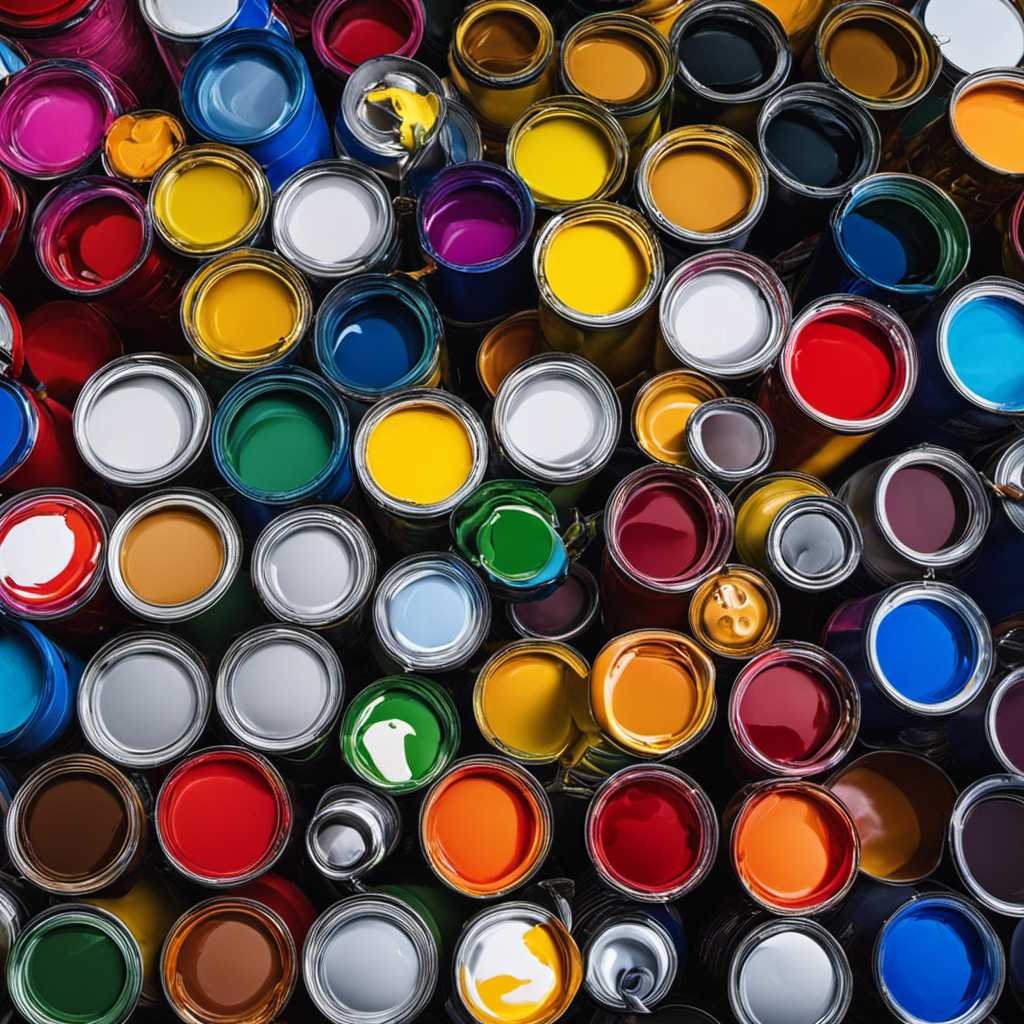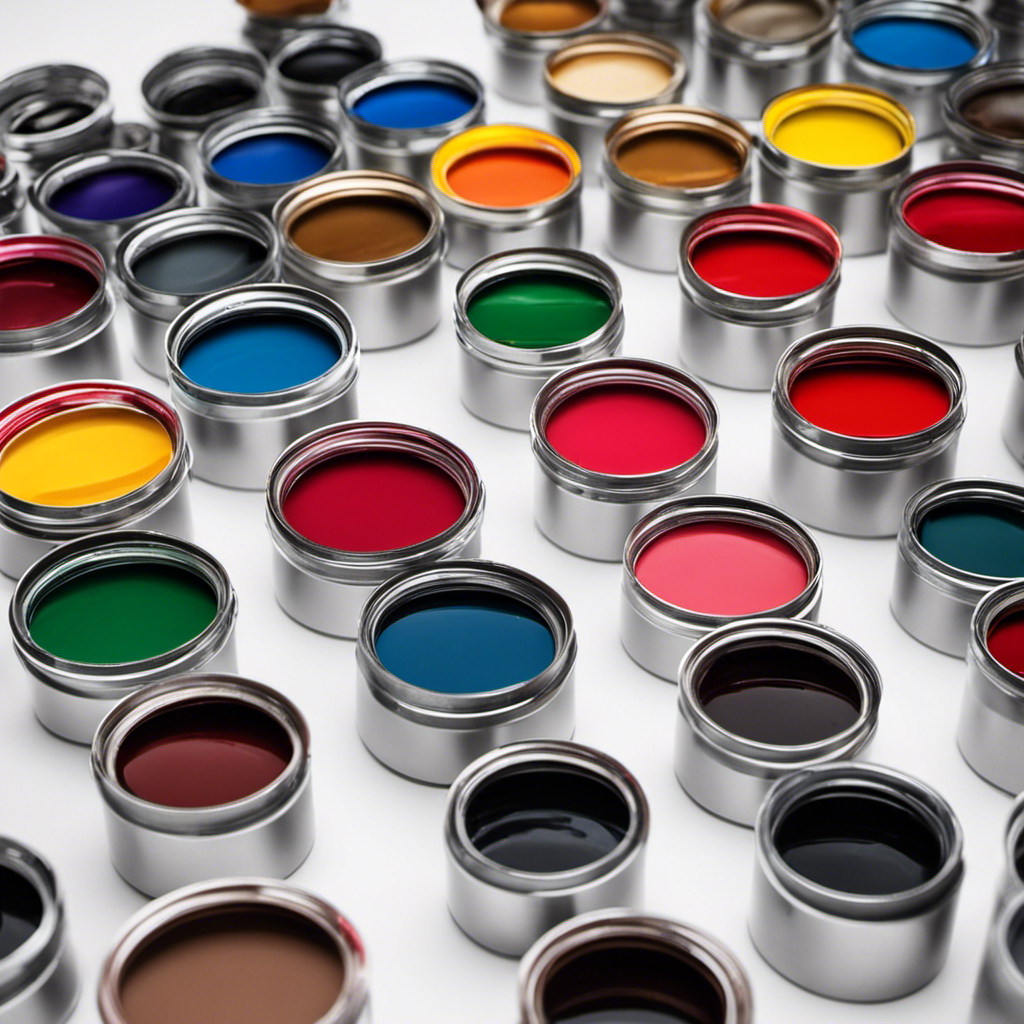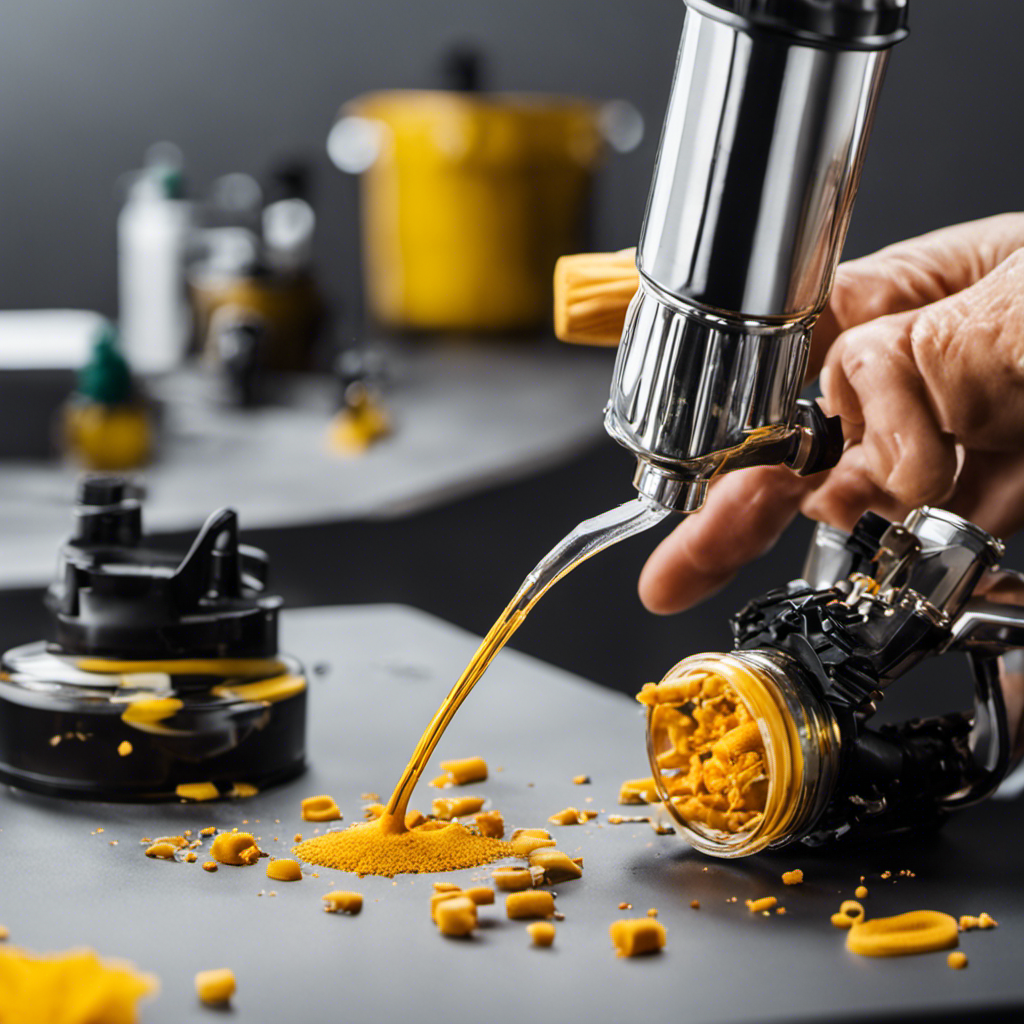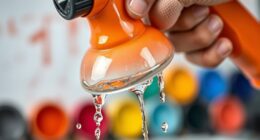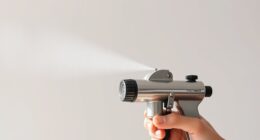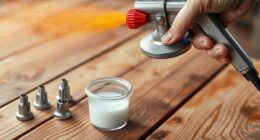Have you ever considered the consequences of being sprayed by an airless paint sprayer? Trust me, it’s far from enjoyable.
In this article, we will delve into the mechanics of an airless paint sprayer, understand the pressure behind the spray, and explore the potential injuries caused by it.
We’ll assess the severity of wounds, discuss long-term effects and complications, and provide steps for proper treatment and recovery.
Plus, we’ll share safety measures to prevent these accidents.
So, let’s dive in and uncover the truth about getting shot by a paint sprayer.
Key Takeaways
- Airless paint sprayers operate without compressed air and use a nozzle to determine the size and shape of the spray pattern.
- Regular cleaning and inspection of the sprayer, especially the nozzle, is important for optimal performance.
- Different nozzles are available for different types of projects.
- Paint from an airless paint sprayer can cause skin irritation, allergic reactions, respiratory issues, and potential damage to the eyes and skin.
The Mechanics of an Airless Paint Sprayer
The mechanics of an airless paint sprayer allow for high-pressure paint spraying without the need for compressed air. Understanding the paint nozzle is key to operating this type of sprayer effectively. The nozzle determines the size and shape of the spray pattern, and different nozzles are available for different types of projects. It is important to choose the right nozzle for the desired outcome.
Additionally, paint sprayer maintenance is crucial for optimal performance. Regular cleaning and inspection of the sprayer, especially the nozzle, will prevent clogs and ensure a consistent spray pattern. Taking the time to understand the mechanics of an airless paint sprayer and properly maintaining it will result in smooth and efficient painting projects.
Now, let’s delve into understanding the pressure behind the spray.
Understanding the Pressure Behind the Spray
Understanding the pressure behind the spray in an airless paint sprayer is crucial. Proper pressure management ensures a high-quality paint application and reduces the risk of accidents. Let’s take a closer look at the pressure levels commonly used in airless paint sprayers:
| Pressure Level | PSI Range | Application |
|---|---|---|
| Low Pressure | 500-1000 PSI | Fine finishing, delicate surfaces |
| Medium Pressure | 1500-2000 PSI | General purpose, walls, ceilings |
| High Pressure | 2500-3500 PSI | Heavy coatings, thick materials |
When working with an airless paint sprayer, it is essential to follow safety precautions to prevent injuries. Wear protective clothing, including goggles, gloves, and a respirator. Keep a safe distance from the sprayer and ensure proper ventilation in the working area. Additionally, always release the pressure before cleaning or performing maintenance on the sprayer.
Understanding the pressure behind the spray helps us comprehend the impact on the skin when the paint hits.
Impact on the Skin: What Happens When the Paint Hits
When paint is sprayed onto the skin, it can cause irritation and potential damage. The force of the paint splatter can lead to several negative effects on the skin, including redness, itching, and inflammation.
Here are three key things to understand about the impact of paint on the skin:
-
Chemical composition: Paint contains various chemicals and pigments that can be harmful when they come into contact with the skin. These substances can penetrate the outer layer of the skin and cause irritation.
-
Allergic reactions: Some individuals may be allergic to certain components in paint, such as solvents or dyes. This can result in more severe skin reactions, such as blistering or hives.
-
Long-term effects: Prolonged or repeated exposure to paint splatter can lead to chronic skin conditions, such as dermatitis or eczema.
Understanding these factors is crucial in order to prevent and address potential injuries caused by the paint sprayer, which will be discussed in the following section.
Potential Injuries Caused by the Paint Sprayer
When it comes to using a paint sprayer, there are several potential dangers to be aware of.
One of the most significant risks is the inhalation of paint fumes, which can lead to respiratory issues and other health problems.
Additionally, the paint can cause damage to the eyes and skin upon contact, making it crucial to take proper safety precautions when using a paint sprayer.
Paint Inhalation Dangers
Paint inhalation dangers can occur when you’re exposed to the fumes from an airless paint sprayer. The toxic chemicals released in the form of paint fumes can have serious consequences on your respiratory system.
Here are three reasons why paint inhalation can lead to respiratory problems:
-
Irritation: Breathing in paint fumes can irritate your nose, throat, and lungs, causing symptoms such as coughing, wheezing, and shortness of breath.
-
Allergic reactions: Some people may be allergic to certain chemicals present in paint, leading to allergic rhinitis, asthma attacks, or even anaphylaxis.
-
Long-term damage: Prolonged exposure to paint fumes can result in chronic respiratory conditions, including bronchitis and lung cancer.
As you can see, inhaling paint fumes can have detrimental effects on your respiratory health. However, it’s important to note that the dangers don’t stop there.
Eye and skin damage can also occur from direct contact with the paint, which I will discuss in the next section.
Eye and Skin Damage
If you’re not careful, direct contact with paint can cause damage to your eyes and skin. That’s why it’s important to always wear proper eye protection when working with paint, such as safety goggles or a face shield.
Paint can irritate the eyes and cause redness, itching, and sometimes even more serious injuries like chemical burns. If you do get paint in your eyes, it’s crucial to seek immediate medical attention.
The treatment options for eye injuries caused by paint will depend on the severity of the damage. In less severe cases, rinsing the eyes with clean water may be sufficient. However, more severe injuries may require specialized treatment, such as eye drops, medications, or even surgery.
Assessing the damage: severity of wounds, will help determine the appropriate course of action.
Assessing the Damage: Severity of Wounds
When it comes to assessing the seriousness of wounds, it is crucial to consider various factors. These factors include the depth, size, and location of the injury. These factors play a significant role in determining the potential complications that may arise. These complications can include infection or damage to underlying structures.
Once the severity and potential complications have been assessed, appropriate treatment options can be explored. These treatment options range from basic wound care techniques to more advanced medical interventions.
Determining Wound Seriousness
Assessing the severity of the wound caused by an airless paint sprayer can be done by considering the depth and size of the injury. When determining wound severity, it is important to take into account the following factors:
- Depth of the wound: A deeper wound may indicate a more serious injury, as it can damage underlying tissues and organs.
- Size of the wound: Larger wounds often require more extensive treatment and may have a longer healing process.
- Location of the wound: Depending on where the wound is located, there may be a higher risk of complications or difficulties in the healing process.
Understanding these aspects is crucial in determining the seriousness of the injury and providing appropriate medical care. By assessing the depth, size, and location of the wound, healthcare professionals can develop an effective treatment plan and monitor the wound healing process.
However, it is also important to assess potential complications that may arise from an airless paint sprayer injury.
Assessing Potential Complications
To determine the severity of any potential complications, it is important to closely monitor the wound caused by the airless paint sprayer. Complication management is crucial in order to minimize the long-term consequences that may arise from such an injury. Here is a table that provides an overview of the potential complications and their respective management strategies:
| Complication | Symptoms | Management |
|---|---|---|
| Infection | Redness, swelling, pus | Clean the wound, apply antibiotic ointment, seek medical attention if symptoms worsen |
| Tissue damage | Bruising, pain, stiffness | Apply ice, elevate the affected area, consult a healthcare professional for further evaluation |
| Scarring | Raised, discolored skin | Apply silicone gel, use sunscreen to protect the area from UV exposure, consider scar revision surgery if necessary |
| Nerve damage | Numbness, tingling | Consult a healthcare professional for evaluation and possible rehabilitation |
| Psychological impact | Anxiety, fear | Seek support from loved ones, consider therapy or counseling if necessary |
Treatment Options for Wounds
There are several treatment options available for wounds caused by an airless paint sprayer. When it comes to wound care, it is important to consider the severity of the injury and the extent of the damage. Here are three treatment options that can be considered for paint sprayer injuries:
-
Cleaning the wound: The first step in treating a paint sprayer wound is to clean it thoroughly. This involves gently washing the area with mild soap and water to remove any paint residue or debris that may be present.
-
Antibiotic ointments: Applying an antibiotic ointment to the wound can help prevent infection and promote healing. This should be done after cleaning the wound and can be followed by covering it with a sterile dressing.
-
Seeking medical attention: In some cases, paint sprayer wounds may be deep or severe and require medical intervention. It is important to seek professional medical help if the wound is large, bleeding heavily, or if there are signs of infection such as redness, swelling, or pus.
Transitioning into the subsequent section about immediate first aid for paint sprayer injuries, it is crucial to act quickly in order to minimize the potential risks and complications associated with such injuries.
Immediate First Aid for Paint Sprayer Injuries
If you get shot by an airless paint sprayer, the first thing you should do is clean the wound and apply pressure to stop the bleeding. Immediate first aid is crucial to prevent potential complications and minimize the risk of infection. After cleaning the wound, it is important to cover it with a sterile dressing to protect it from further contamination. Here is a table that highlights the potential complications of paint sprayer injuries and some tips for preventing accidents:
| Complications | Prevention Tips |
|---|---|
| Infection | Use personal protective equipment such as gloves and goggles. Clean the equipment regularly. |
| Tissue damage | Follow the manufacturer’s instructions for proper use of the paint sprayer. Maintain a safe distance from the spraying area. |
| Allergic reactions | Avoid using paint sprayers if you have a known allergy to the chemicals used. Perform a patch test before using new products. |
| Eye injuries | Wear protective eyewear to shield your eyes from accidental splashes or sprays. |
Long-Term Effects and Complications
Remember, regular check-ups with a healthcare professional are essential to monitor any potential long-term effects and complications from your injury. It’s important to understand the possible consequences of being shot by an airless paint sprayer.
Here are three key points to consider:
-
Long-term effects: Depending on the severity of the wound, you may experience long-term effects such as chronic pain, limited mobility, or even nerve damage. These effects can significantly impact your daily life and require ongoing medical attention.
-
Complications: Paint sprayer injuries can lead to complications such as infections, scarring, or tissue damage. These complications may require additional treatment options, such as antibiotics or surgeries, to ensure proper healing and prevent further issues.
-
Treatment options: The treatment for long-term effects and complications will vary based on the specific injury. It may involve physical therapy, medication, wound care, or even rehabilitation programs. Consulting with a healthcare professional will help determine the most suitable treatment plan for your situation.
Understanding the potential long-term effects and complications of a paint sprayer injury highlights the importance of seeking prompt medical attention.
Seeking Medical Attention: When and Why
After discussing the long-term effects and complications of getting shot by an airless paint sprayer, it is important to understand when and why seeking immediate medical attention is crucial.
When it comes to injuries caused by paint sprayers, it is always better to err on the side of caution and seek medical help as soon as possible. The force and pressure of the paint can cause internal damage that may not be immediately apparent. Furthermore, there is a risk of infection from the paint entering the body. Seeking medical attention promptly can help prevent further complications and ensure proper treatment is administered. With the potential seriousness of this type of injury, it is essential not to delay in seeking medical care.
Transitioning to the subsequent section on steps to take for proper treatment and recovery, it is important to know what actions to take after seeking medical attention.
Steps to Take for Proper Treatment and Recovery
When it comes to dealing with injuries caused by an airless paint sprayer, there are three key points to consider:
-
Immediate first aid is crucial in order to minimize further damage and prevent infection.
-
Seeking medical attention is essential to properly assess and treat the injury, as well as to ensure any underlying complications are addressed.
-
The long-term recovery process may involve physical therapy, wound care, and ongoing medical treatment to achieve optimal healing and function.
Immediate First Aid
If you get shot by an airless paint sprayer, you should immediately rinse the affected area with clean, cool water. This is crucial for paint sprayer safety and proper wound care.
Here are three important things to keep in mind when dealing with this type of injury:
-
Remove any clothing or jewelry near the wound to prevent further irritation or contamination.
-
Gently pat the area dry with a clean towel or cloth after rinsing to avoid causing additional damage to the skin.
-
Apply a sterile, non-stick bandage or gauze pad to protect the wound from dirt and bacteria.
Medical Attention Required
Remember, it’s crucial to seek immediate medical attention for a gunshot wound caused by an airless paint sprayer.
The severity of the injury may not be immediately apparent, so it is important to be aware of the warning signs and symptoms that may indicate the need for medical attention. These can include severe pain, excessive bleeding, difficulty breathing, or signs of infection such as redness, swelling, or pus.
To assess the severity of the injury, you can perform a self-assessment by checking for any obvious entry and exit wounds, evaluating the amount of bleeding, and assessing your overall physical condition. However, it is important to note that even if the injury appears minor, it is still recommended to seek medical attention as there may be internal damage that needs to be addressed.
Moving forward into the long-term recovery process, it is crucial to follow the guidance and treatment plan provided by medical professionals to ensure proper healing and minimize the risk of complications.
Long-Term Recovery Process
To ensure proper healing and minimize the risk of complications, it’s crucial that you follow the guidance and treatment plan provided by medical professionals during your long-term recovery process.
The rehabilitation process after being shot by an airless paint sprayer can be challenging, both physically and mentally. Here are three important aspects to consider:
-
Physical therapy: Engaging in exercises and stretches recommended by your healthcare provider can help restore strength and mobility to the affected area. This may involve using specialized equipment or undergoing manual therapy techniques.
-
Psychological support: Dealing with the aftermath of such an incident can have a significant psychological impact. Seeking therapy or counseling can provide a safe space to process emotions, manage anxiety, and build resilience during the recovery journey.
-
Follow-up appointments: Regular check-ups with your healthcare team are essential for monitoring progress, addressing any concerns, and adjusting the treatment plan accordingly.
Transitioning into the subsequent section about preventing paint sprayer accidents: safety measures to follow, it’s important to take proactive steps to avoid such incidents in the first place.
Preventing Paint Sprayer Accidents: Safety Measures to Follow
Following safety measures is crucial when using a paint sprayer to prevent accidents. As someone who has experienced the dangers of paint sprayer accidents firsthand, I cannot stress enough the importance of taking precautions.
First and foremost, always wear protective gear, including goggles, gloves, and a respirator mask, to shield yourself from harmful fumes and overspray.
Additionally, ensure that the work area is well-ventilated to minimize the risk of inhaling toxic chemicals. It is also essential to read and understand the manufacturer’s instructions before operating the paint sprayer, as each model may have specific safety guidelines.
Frequently Asked Questions
Can an Airless Paint Sprayer Cause Permanent Damage to the Skin?
An airless paint sprayer can cause permanent damage to the skin, including permanent scarring. This can have legal implications if someone is injured by the sprayer. It is important to take proper precautions when using such equipment.
Are There Any Long-Term Health Complications That Can Occur From Being Shot by an Airless Paint Sprayer?
Long-term health complications can arise from being shot by an airless paint sprayer. Treatment options vary depending on the severity of the injury. It’s crucial to seek medical attention immediately to minimize potential damage.
What Steps Should Be Taken Immediately After Being Shot by an Airless Paint Sprayer to Minimize Injury?
After getting shot by an airless paint sprayer, the immediate steps to minimize injury include seeking medical attention, cleaning the wound with antiseptic techniques, and starting the rehabilitation process for a successful recovery.
How Long Does It Typically Take to Recover From Injuries Sustained From an Airless Paint Sprayer?
Recovery timeline and the rehabilitation process can vary depending on the severity of the injuries sustained from an airless paint sprayer. It’s important to consult with medical professionals for an accurate assessment and personalized treatment plan.
What Safety Measures Should Be Followed to Prevent Accidents With Airless Paint Sprayers?
To prevent accidents with airless paint sprayers, it is crucial to prioritize proper training and avoid common mistakes. This ensures safety for all involved and minimizes the risk of harm.
Conclusion
In conclusion, experiencing the impact of an airless paint sprayer is a chilling and terrifying ordeal. The force behind the spray can cause severe damage to the skin, leaving behind painful wounds that may have long-term effects.
The image of paint forcefully penetrating the skin is enough to send shivers down one’s spine. It is crucial to seek immediate medical attention and follow proper treatment protocols to ensure a successful recovery.
Remember, taking necessary safety measures is the key to preventing such accidents and protecting oneself from this haunting experience.
Drenched in creativity and armed with a fountain pen, Isolde weaves words as gracefully as a painter strokes their canvas. A writer for Paint Sprayer Zone, her passion for colors, textures, and spaces finds a harmonious blend with her profound knowledge of painting tools and techniques.
Having grown up in a family of artists, Isolde’s tryst with paints began early. While her relatives expressed themselves on canvas, Isolde found her medium in words. She dedicated herself to chronicling the world of painting, understanding the nuances of each tool, and the artistry behind every spritz of a paint sprayer.

